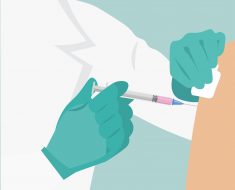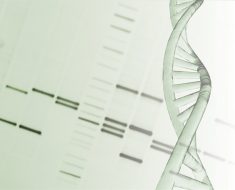A life-saving cure solution for Menkes Disease, a copper deficiency in young children, is at the center of a licensing agreement by The Texas A&M University System, through the Intellectual Property and Commercialization office of Texas A&M AgriLife Research, and a California-based biopharmaceutical company, Engrail Therapeutics.
The Texas A&M University research team, led by Vishal Gohil, Ph.D., an associate professor in the Department of Biochemistry and Biophysics of the College of Agriculture and Life Sciences, was responsible for the discovery.
Menkes disease is an inherited, fatal pediatric disease caused by impaired absorption and distribution of dietary copper in the body. The disease primarily affects the nervous system and typically manifests during the first few months of life, rapidly progressing over time. Symptoms include sparse and brittle hair, slow growth or failure to thrive, and seizures. Additional features may include low muscle tone, sagging facial features, and developmental and intellectual disability.
"There are currently no approved treatments for Menkes disease," Gohil said.
Gohil's lab identified that an experimental pharmaceutical compound, Elesclomol, could be used to improve copper levels in critical organs such as the brain and could offer a potential treatment for diseases related to copper deficiency, like Menkes disease.
Engrail Therapeutics, a neuroscience company focused on the acquisition, development and commercialization of patient-centric therapies, became aware of Gohil's discovery. The company rapidly initiated discussions with Texas A&M AgriLife's Intellectual Property and Commercialization office on licensing rights in intellectual property for the use of Elesclomol for disorders of mitochondrial copper metabolism.
"Several companies contacted us with interest in Dr. Gohil's discovery," said Janie Hurley, AgriLife Intellectual Property and Commercialization director. "In our discussions with Engrail, it was apparent that this company had the capabilities and the passion for seeing this discovery further developed into a potential treatment to provide hope for those families suffering from this devastating disease."
Under their license agreement, Engrail now leads development of a complex of Elesclomol-copper for the treatment of Menkes disease, while AgriLife Research continues conducting preclinical research through a sponsored research grant.
'A lethal disease'
Children with Menkes disease can die by 3 years of age; it's quite simply a lethal disease. Children as young as 3 months old start experiencing seizures, their hair becomes very brittle, tangled and kinky -; in fact this disorder is also known as the 'kinky hair syndrome.' All of these symptoms are due to copper deficiency, because copper absorption from the gut doesn't occur as it should, due to a genetic defect."
Vishal Gohil, Ph.D., Associate Professor, Department of Biochemistry and Biophysics of the College of Agriculture and Life Sciences
The license agreement sets the stage for future clinical trials to be conducted by Engrail. This work builds on initial research started in Gohil's lab, which has garnered significant attention from the scientific, medical and patient communities. An AgriLife Today video report drew several inquiries worldwide from those seeking possible cures.
"We received inquiries from families who are desperate because there is no cure," he said. "We've received inquiries not only in the U.S., but from the world over including India, Israel, Spain, Sweden and the U.K. They were desperately looking for some type of treatment. We are hoping to find a cure through this research."
"Engrail has provided funds to support research in our laboratory, and we will be closely working with them over the next few years," Gohil said.
Copper is a necessity
Gohil said that although the human body requires "just a pinch" of copper, the element is necessary for the activity of crucial enzymes in the body, such as cytochrome oxidase.
"This enzyme is present in the cellular powerhouse – the mitochondria," he said. Cytochrome oxidase "transfers electrons from the food we eat to the oxygen we breathe, and in this process produces energy that we need to grow, survive and thrive."
Typically, the body obtains the copper it requires from foods, including rice, meat, bread, nuts and shellfish. Some foods have more copper than others.
"In our gut, where food is digested, there are specific transporters that bring copper into the cells and ultimately into the blood," Gohil said. "We need two transporters for all of this to function properly."
Gohil said the CTR1 copper transporter allows intestinal cells to absorb copper from food. Another transporter in intestinal cells, called ATP7A, is required for exporting the dietary copper into the blood. In Menkes disease, the patient's ATP7A is either absent or does not function well, preventing copper from being exported. In addition to its activity in intestinal cells, ATP7A is also required for copper transport into the brain.
"What we have found is that Elescomol bypasses the absent transporter, making copper available to brain and other tissues in mice that have Menkes disease," he said. "Up until this point, large drug companies have been reluctant to carry out this research. Huge investments and rare cases of Menkes have not provided much incentive for them."
However, Gohil's lab has seized the opportunity and looks to further expand its scope of work.
"This research is not just limited to Menkes and other human diseases of copper deficiencies," he said. "This can also be applicable to livestock that have copper deficiencies."
He referenced the early work of an Australian scientist, David Danks, Ph.D., who in the 1970s made the critical connection between the kinky hair in patients with Menkes syndrome and the wool of sheep that foraged on copper-depleted soil.
With treatments, it is entirely possible that a rancher would be able to rescue such animals. A horse born with copper deficiency could be given an injection to survive.
For now, the focus of the research in the Gohil lab is to support development of this potential cure for Menkes disease.
Texas A&M AgriLife Communications
Posted in: Drug Discovery & Pharmaceuticals | Child Health News | Biochemistry
Tags: Agriculture, Biochemistry, Biopharmaceutical, Blood, Brain, Bread, Children, Compound, Copper, CT, Disability, Enzyme, Food, Genetic, Hair, Horse, Laboratory, Meat, Menkes Disease, Metabolism, Mitochondria, Muscle, Nervous System, Neuroscience, Oxygen, pH, Preclinical, Research, Syndrome, Therapeutics
Source: Read Full Article





